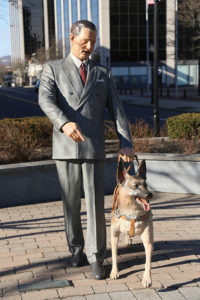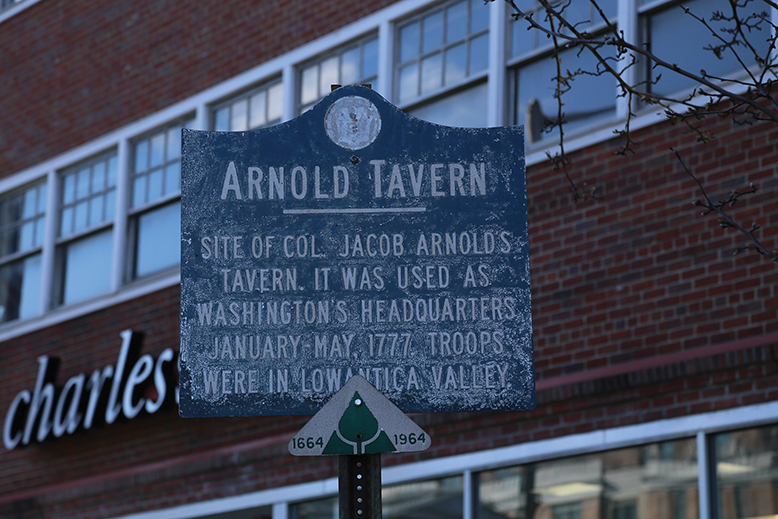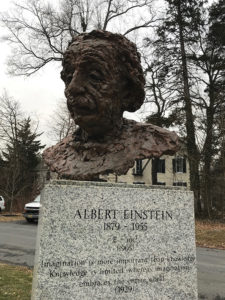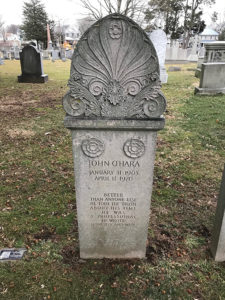
Few states can claim as many historic sites as New Jersey. These five city walks take you back in time.
1. Bordentown (Burlington County)
Start: Prince and Courtland streets
Distance: 1.25-mile loop
This walk starts at the statue of Revolutionary War author and activist Thomas Paine, a onetime resident of this Delaware River city. Proceed north on Courtland Street and turn right (away from the river) on Farnsworth Avenue. At 32 Farnsworth, you’ll reach the home of another local patriot, Joseph Borden, son of the town’s namesake. Your next stop is 101 Farnsworth, the imposing brick home of Francis Hopkinson, a signer of the Declaration of Independence. Across the street, Common Sense Brewing (102 Farnsworth), named for Paine’s influential pamphlet, offers refreshment Friday-Sunday. Continue to the restored 1740 Friends Meeting House at 302 Farnsworth. At 358 Farnsworth you’ll reach the Record Collector, where you can search the bins of old vinyl LPs. Heading back, turn right on Crosswicks Street and walk five blocks to Burlington Street to see the red-brick schoolhouse where Red Cross founder Clara Barton taught in the 1850s. Dining options include Oliver a Bistro (218 Farnsworth) and Jester’s Café (233 Farnsworth). Park on the street or city parking lots.—Tom Wilk

The landmark Colgate Clock on the Jersey City waterfront Photo by Jennifer Brown
2. Jersey City (Hudson County)
Start: Empty Sky 9/11 Memorial
Distance: 5-6-mile loop
Although a building boom has changed the face of the Jersey City waterfront, several well-preserved historic neighborhoods remain in the downtown area. Start in Liberty State Park (use the free Statue of Liberty parking area) with a visit to the Empty Sky 9/11 Memorial and the neighboring Central Railroad Terminal. Here you can enjoy sweeping views of the Statue of Liberty and the Manhattan skyline. Walk along the water’s edge away from the river and through the Liberty Landing Marina, then cross the Morris Canal footbridge onto Jersey Avenue. Continue north on Jersey Avenue about six blocks to the neighborhood around Van Vorst Park, with its tree-lined streets and preserved, 19th-century brownstones. The redstone Heppenheimer Mansion (now condos) on the corner of Jersey and Montgomery streets dates to 1884. Turn right into the park, then left on Barrow Street and right on Wayne Street to pass the 1837 Greek Revival Barrow Mansion, named for an in-law of the Van Vorsts, now a community center. Return to Barrow Street and head toward the lively Newark Avenue Pedestrian Mall. Here you can pick up a street map at Word Bookstore or sustenance at Porta, Two Boots or Roman Nose. Turn right at Grove Street and walk past the massive, 1892 granite-and-marble City Hall. Turn left at Grand Street and proceed to the Paulus Hook Monument at Washington Street. Turn right on Washington, right on Sussex Street, left on Warren Street and left on Morris Street to soak up the ambience of Paulus Hook, a beautiful, preserved neighborhood first populated by Dutch settlers in the 1600s. Follow Morris toward the river until you reach the Hudson River Waterfront Walkway. Walk past the Goldman Sachs Tower, New Jersey’s tallest building, and you’ll come face-to-face with a true icon, the 1924 Colgate Clock. Follow the Waterfront Walkway to Warren Street, where you can catch a ferry back to Liberty State Park (every 30 minutes weekdays, 60 minutes weekends).—Pegi Adam

The longtime home of political cartoonist Thomas Nast Photo by Laura Baer
3. Morristown (Morris County)
Start: 11 DeHart Street
Distance: 1.5-mile loop

The lifelike statue of Morris Frank, founder of the Seeing Eye Photo by Laura Baer
First settled in 1715, the city of Morristown has a rich history, much of it centered on the American Revolution. Start in the municipal parking lot next to 11 DeHart Street. Leaving the lot on DeHart, turn left and left again on South Street, then proceed to the Morristown Green. Now a public park, the Green was used as a parade ground by George Washington’s Continental Army in the winter of 1777.
At the center of the Green, take a selfie with the life-size statues of Washington chatting with Alexander Hamilton and the Marquis de Lafayette. For another selfie, look for the statue of Morris Frank, founder of the Seeing Eye, on a traffic island at the far corner of the Green. Now cross East Park Place to the stone Presbyterian Church and Burying Ground. The current church, the third on the site, dates to 1893. Note the sundial to the right of the church, marking the spot of the original church where Washington took Holy Communion in 1777. Behind the church, you can wander through the graveyard, with many tombstones from the 1700s. Now retrace your steps to South Street and head back toward DeHart. You’ll pass Morristown’s restaurant row and a series of historic buildings, starting on the right with the Dr. Lewis Condict House (51 South Street), a 1797 Federal-style residence. Nearby is the restored, 18th-century Wood Farmhouse (83 South Street) where Lafayette stayed on his return to Morristown in 1825. At the corner of South and Miller streets, gaze up at the austere Norman tower of the 1897 St. Peter’s Episcopal Church.

Historic marker on the Morristown Green indicates location of the tavern that served as George Washington’s HQ from January-May 1777 Photo by Laura Baer

The tower of St. Peter’s Episcopal Church, built in 1897 Photo by Laura Baer
Across from the church is the Vail Mansion, former home of Theodore Vail, an early president of AT&T and the architect of the Bell System. The mansion now houses Jockey Hollow, a New Jersey Monthly Top 30 restaurant. Now walk down Miller Street alongside St. Peter’s until you reach Macculloch Avenue. The large, white corner house on your right—a national landmark—is the longtime home of 19th-century political
cartoonist Thomas Nast, who gave us the modern images of Santa Claus and Uncle Sam. Across Macculloch Avenue is the Kedge, an unusual brick-and-shingle home from the 1870s. Immediately next door is the Federal-style Macculloch Hall Historical Museum. The sturdy brick mansion—built in the 1810s—is now a museum of early-American decorative arts and features the world’s largest collection of works by cartoonist Nast. (Museum open 1-4 pm, Wednesday, Thursday and Sunday; the gardens in the rear are free and open daily.) Across from Macculloch Hall is the Admiral Rogers House, an 1852 Victorian with a magnificent display of wisteria on its broad front porch. Proceed on Macculloch and turn right on Dehart to return to your car. To complete your Morristown tour, drive up the steep hill behind the county courthouse to Fort Nonsense, which provides a broad view over the city. Then head to the Ford Mansion and Washington’s Headquarters Museum (30 Washington Place) for a full dose of Revolutionary history.—Ken Schlager

Princeton’s Einstein bust Photo by Ken Schlager
4. Princeton (Mercer County)
Start: 55 Stockton Street
Distance: 2-mile loop
Our walk begins at Morven Museum & Gardens; there’s ample free parking to the rear. Richard Stockton, a signer of the Declaration of Independence, built the pre-Revolutionary mansion; it later served as the residence of five New Jersey governors and is now an art and history museum (open Wednesday-Sunday). A pathway to the right of Morven leads to the Princeton Battle Monument, a towering marble-and-granite tribute to George Washington’s victory at the Battle of Princeton in 1777. Continue on the path to the Einstein bust, dedicated in 2005 to the memory of Princeton’s most famous 20th-century resident. Proceed for three blocks on Nassau Street to Palmer Square on your left. Here you can stroll among boutiques and gift shops and grab a coffee at Rojo’s Roastery or an ice cream at the esteemed Bent Spoon. The Nassau Inn at the center of the square is home to the Yankee Doodle Tap Room. Step inside (entrance next to Lindt Chocolate Shop) for a look at the large Norman Rockwell mural behind the bar. Walk through the bar to the dining room and examine the gallery of graduation photos of some 60 Princeton alums, including Jeff Bezos, James Stewart, Bill Bradley and Michelle Robinson Obama (class of ’85). Exit the Yankee Doodle near the photo gallery, turn left, then right on Hulfish Street and left on Witherspoon Street to reach the Princeton Cemetery. Follow Wiggins Street to Grandview Avenue to locate the cemetery entrance. Using a map from the honor box, you can find the graves of U.S. president Grover Cleveland, his wife, Frances, and their daughter, Ruth; novelist John O’Hara; businessman Paul Tulane; U.S. vice president Aaron Burr; and other famous

Novelist John O’Hara’s grave in Princeton Photo by Ken Schlager
Princetonians. After leaving the cemetery, follow Vandeventer Avenue across Nassau Avenue to the university campus. Continue up Washington Road and enter the campus on your right, between Firestone Library and the massive University Chapel. For a break from the itinerary, turn left in front of the chapel to reach the Princeton Art Museum, with its fantastic collection of art and photography from around the world (open Tuesday-Sunday; free). To continue on your way, proceed across from the chapel, past the statue of John Witherspoon and through the arches of Pyne Hall to Nassau Hall, where British troops surrendered to Washington after the Battle of Princeton. Exit the campus in front of Nassau Hall and turn left to pass the 1756 MacLean House, original residence of the college presidents, and the Nassau Presbyterian Church. Continue on Nassau Street to Stockton Street to return to Morven.—KS
5. Woodbury (Gloucester County)
Start: 1 North Broad Street
Distance: 1-mile loop
Broad Street offers an educational journey through Woodbury’s past. A Civil War monument outside the county courthouse (1 North Broad Street) honors 181 Union dead. A few steps away is the World War I Doughboy Sculpture (19 North Broad). The Sailing to Freedom Mural (161 North Broad) commemorates the Wood family of Bury, England, who arrived in 1683 and gave the city its name. Cross at the Red Bank Avenue intersection for a slight uphill return on the other side of Broad Street. Take a detour into Broad Street Lake and Park to stroll along the paths and grassy areas. The Woodbury Friends Meeting House (120 North Broad) is your next stop. Built in 1715-16, it is the city’s oldest public building and was used at different times by Colonial and British troops during the Revolution. The Gloucester County Historical Society Museum (58 North Broad) is housed in the 1765 Hunter-Lawrence-Jessup house, once the home of Captain James Lawrence, who uttered the words “Don’t give up the ship” as he lay dying during the War of 1812. Next to the house is a historic marker indicating the November 1777 headquarters of British general Cornwallis. Enjoy lunch or dinner at Charlie Brown’s (111 North Broad) or grab a snack at Fiore’s Bagel Nook & Café (5 Delaware Street). Park for free at the county garage, North Broad and Hunter streets. A walking tour map is available at the city library (33 Delaware Street).—TW
